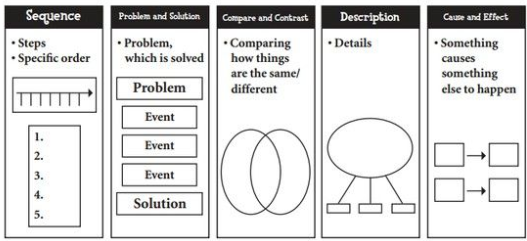- Author:
- KASEY KUZMA
- Subject:
- English Language Arts, Reading Informational Text
- Material Type:
- Lesson Plan
- Level:
- Upper Primary
- Grade:
- 3, 4
- Tags:
- License:
- Creative Commons Attribution
- Language:
- English
Education Standards
Text Structure Note Sheet
Types of Text Structure
Overview
Use this lesson to introduce the 5 types of text structure to your students.
| E.Q / I Can | Standard/Skills | |
| I can identify and explain different structures used in informational text. | RI.4.5 Describe the overall structure of events, ideas, concepts, or information in a text or part of a text. | |
| Content Vocabulary: Text Structure, Cause, Effect, Compare, Contrast, Description, Sequence, Chronological Order, Problem, Solution | ||
| Day 1 | ||
| Introduce Vocabulary with PPT.Activating Strategy: Ask students to Turn & Talk: What do you know about text structure? | I DO: Explain to students that we are switching gears to nonfiction. Nonfiction readers think about how texts are organized. Authors organize their writing in certain ways to help readers better understand the text. This is called text structure.Play Text Structure Video | WE DO: Today we will focus on one type of text structure, Description. Walk through powerpoint. Students will glue note sheet into their notebooks and follow along, filling in the blanks. |
| Day 2 | ||
| Activating Strategy: Show students an example of a Descriptive text structure from powerpoint. Turn & Talk: What is Text Structure? What type of text structure does this text have? How do you know? | I DO: Show Sandlot Video. Have students discuss what the characters are doing. (Ham shows Smalls how to make smores.)Explain to students that today we will focus on another type of text structure, Sequence/Chronological Order. | WE DO: Walk through powerpoint. Students will use note sheet to follow along, filling in the blanks. |
| Day 3 | ||
| Activating Strategy: Show students an example of a Descriptive and Sequence text structure from powerpoint. Turn & Talk: What is Text Structure? What type of text structure does this text have? How do you know? | I DO: Show students clip from Matilda. Ask what the creator of this movie is doing throughout the scene (comparing/contrasting how she is growing and changing.Explain to students that today we will focus on another type of text structure, Compare and Contrast. | WE DO: Walk through powerpoint. Students will use note sheet to follow along, filling in the blanks. |
| Day 4 | ||
| Activating Strategy: Show students an example of a Descriptive, Sequence, and Compare/Contrast text structure from powerpoint. Turn & Talk: What is Text Structure? What type of text structure does this text have? How do you know? | I DO: Today we will focus on another type of text structure, Cause and Effect. Show Cause and Effect Video. | WE DO: Show students clip from Captain Underpants. Allow students to discuss the cause/effect they are seeing. Walk through powerpoint. Students will use note sheet to follow along, filling in the blanks. |
| Day 5 Writing | ||
| Activating Strategy: Show students an example of a Descriptive, Sequence, Compare/Contrast, and Cause/Effect text structure from powerpoint. Turn & Talk: What type of text structure does this text have? How do you know? | I DO: Show students the clip from The Little Rascals. Ask students if they can identify a new structure. Tell them to think about what they are doing and why.Explain to students that today we will focus on another type of text structure, Problem & Solution | WE DO: Walk through powerpoint. Students will use note sheet to follow along, filling in the blanks. |
| Graphic Organizer: | Glossary |
 | Text Structure: How a written piece is put together (constructed)Cause: Something or someone that makessomething happen or produces aneffectEffect: The result of a change or somethingthat happened (what happened)Compare: To look at two or more things and see how they are alikeContrast: To look at two or more things to see how they are differentDescription: The author describes a topic by giving its characteristics or featuresSequence: Describes items or events in order or tells the steps to follow to do something or make something.Chronological Order: Steps in the order in which they happened in the story and usually will appear in autobiographiesProblem: Something that is hard to deal with and must be overcomeSolution: Solving a problem |
As you are learning about the different types of text structure, use the note sheet to guide you. Fill in the missing parts from the powerpoint.